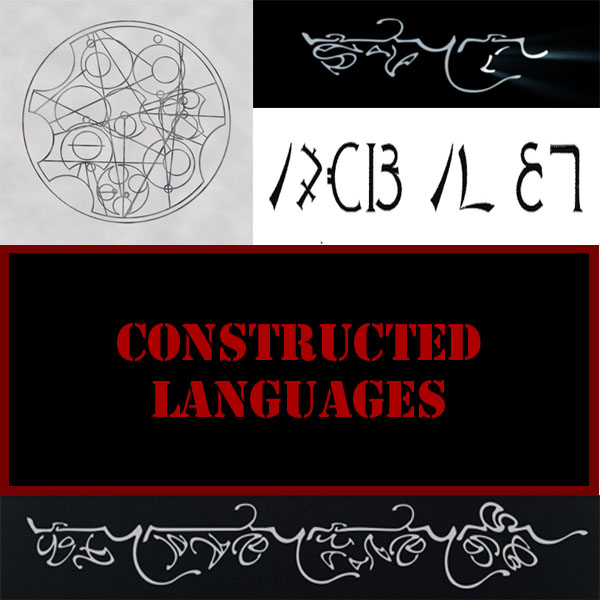3 Con-Langs You Should At Least Be Aware Of

Each set of symbols here actually does say something. The option of decoding them is entirely up to you.
Mar 18, 2014
Somewhere within the conception process for a cult hit, there is always a moment when someone asks the “realism” question: How realistic do you really want your fictional world to be? In some cases, the answer to that question lies in as simple a concept as language.
Constructed languages, or con-langs, are languages or forms of writing created with just enough of an established vocabulary and/or grammar rules to make them seem real. Oftentimes, con-langs are created to add a deeper level of realism to works of fiction in various forms of media, such as TV shows, films, novels, and even comics. Below are 4 very well known constructed languages.
1. Kryptonian: Created in 2013 by Dr. Christine Schreyer and Kirsten Franson for the Warner bros film “Man of Steel”, Kryptonian is classified specifically as a form of alphabet called an abugida. An abugida (or an alphasyllabary, whichever you prefer) is an segmental writing system shown as units consisting of consonant symbols combined with secondary vowel notation. For those who can’t speak geek, it basically means that each translated consonant-vowel group shows up as a symbol with a notation, representing the consonant and the vowel as such. In the case of Kryptonian specifically, each consonant has a symbol and the vowels show up as subtle notations on the line above the consonant symbols. In the film, Kryptonian is the official written language of Krypton, Superman’s planet of birth. Being many generations old, members of old Kryptonian high society often wore clothes and used tools and weapons passed down between family members. These family heirlooms often had Kryptonian inscriptions stitched or engraved onto their surfaces.
2. Circular Gallifreyan: According to the lore surrounding the hit cult TV series Doctor Who, Circular Gallifreyan is the official writing system of the planet Gallifrey and of its inhabitants, the Time Lords. The show’s protagonist, known only as “The Doctor”, is the last surviving Time Lord following the end of a war between species on an interplanetary level. This Time War, fought between the Time Lords and another species of extraterrestrial known as the Daleks, drew to a close with the (almost) complete obliteration of the Time Lords and their planet. Left to travel through all of space and time alone (through the use of a ship known as the TARDIS), it is known that at least the tenth incarnation of The Doctor tends to write himself little notes in Circular Gallifreyan and paste them to a monitor inside the TARDIS. Little is known about when Circular Gallifreyan was established, but the legible and writable version was developed by a fan of the Doctor Who TV franchise called Loren Sherman. Sherman’s Circular Gallifreyan is constructed as an abugida (or alphasyllabary), where each consonant symbol has a vaguely circular shape and the vowel notations are also reminiscent of circles. Circular Gallifreyan is read/written counterclockwise from the bottom of the main word/sentence circle.
3. Enochian: Officially “discovered” (Or created. The debates still go on.) by Dr. John Dee and Edward Kelley in 1583, Enochian is supposedly the officially spoken and written language of Heaven and the Angels of God. It is also the only script on this list that was not created specifically for the sole purpose of existing in a work of fiction. The Enochian alphabet officially consists of 22 distinct letters which each correspond to a specific letter (or letters) in the normal English alphabet. The only English letters which share Enochian translations are C and K, G and J, and U and V, while W has no Enochian equivalent whatsoever. Enochian’s single main grammar rule is that while sentences are still written on a page from top to bottom, they must also be written from right to left. In 2008, the cult TV show “Supernatural” adopted the Enochian language into its lore as a recurring element when, starting in season 4, the protagonists repeatedly began to have dealings with angels.
These are but 3 examples of many other existing constructed languages. Among the others are Klingon, Elvish, Na’vi, and more! So the next time you’re watching a movie or a TV show, and you see or hear a character start to speak or write in what you perceive to be gibberish, just know that the odds are that it’s a con-lang, and that there was a lot of planning and structure behind it.













Prolexin reviews • Apr 22, 2014 at 1:39 am
As the admin of this web site is working, no
hesitation very quickly it will be famous, due to its feature
contents.
My weblog :: Prolexin reviews